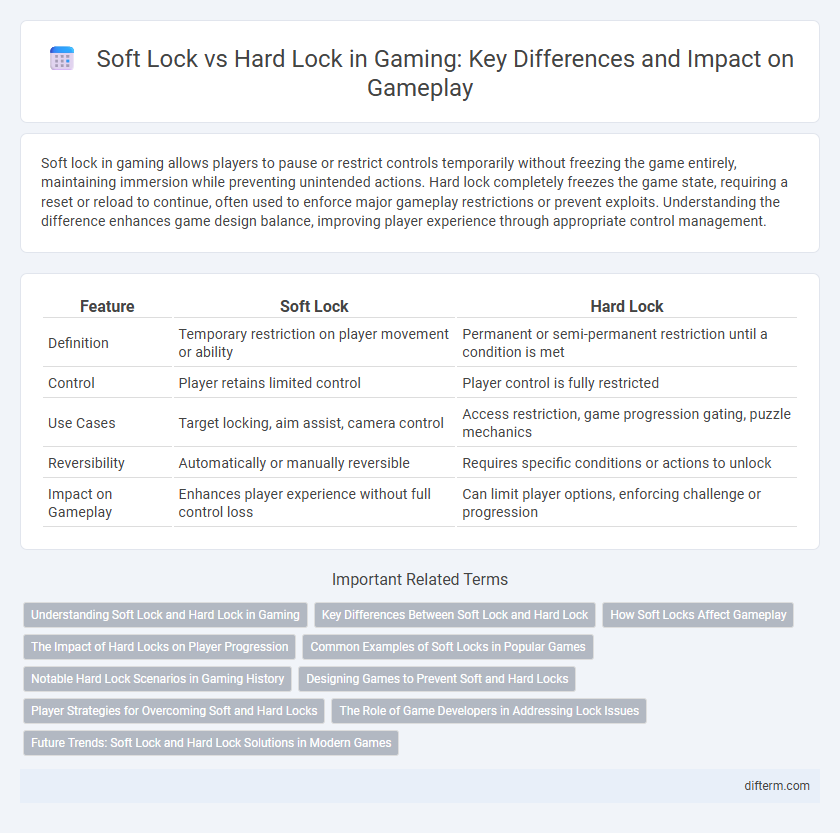Soft lock in gaming allows players to pause or restrict controls temporarily without freezing the game entirely, maintaining immersion while preventing unintended actions. Hard lock completely freezes the game state, requiring a reset or reload to continue, often used to enforce major gameplay restrictions or prevent exploits. Understanding the difference enhances game design balance, improving player experience through appropriate control management.
Table of Comparison
| Feature | Soft Lock | Hard Lock |
|---|---|---|
| Definition | Temporary restriction on player movement or ability | Permanent or semi-permanent restriction until a condition is met |
| Control | Player retains limited control | Player control is fully restricted |
| Use Cases | Target locking, aim assist, camera control | Access restriction, game progression gating, puzzle mechanics |
| Reversibility | Automatically or manually reversible | Requires specific conditions or actions to unlock |
| Impact on Gameplay | Enhances player experience without full control loss | Can limit player options, enforcing challenge or progression |
Understanding Soft Lock and Hard Lock in Gaming
Soft lock in gaming refers to a state where the player's progress is hindered or trapped within the game mechanics, but recovery or escape is possible without restarting, often due to puzzles or in-game glitches. Hard lock describes a critical failure where the game becomes completely unresponsive or crashes, forcing a full restart or reset to continue. Understanding these locks helps developers improve gameplay fluidity and enhances player experience by minimizing frustrating interruptions.
Key Differences Between Soft Lock and Hard Lock
Soft lock in gaming restricts player movements within a specific area or angle, often used for aiming assistance or camera control, allowing some freedom of motion within limits. Hard lock completely immobilizes the player or target, preventing any movement or input until the lock is released, commonly seen in puzzle games or scripted events. The key difference lies in the degree of control; soft lock offers partial directional constraint, while hard lock imposes total movement prohibition.
How Soft Locks Affect Gameplay
Soft locks in gaming disrupt player progression by causing temporary freezes where input is ignored but the game remains responsive internally, often resulting from bugs or unintended mechanics. These interruptions hinder gameplay flow, forcing players to restart sections, which can lead to frustration and decreased engagement. Unlike hard locks, soft locks allow recovery without complete crashes, yet their subtle persistence impacts player experience and challenge balance significantly.
The Impact of Hard Locks on Player Progression
Hard locks in gaming create significant barriers by completely restricting access to certain content or gameplay areas until specific conditions are met, directly halting player progression and potentially causing frustration. This type of lock enforces strict gating mechanisms, such as mandatory quest completions or item acquisitions, which can disrupt player flow and diminish engagement. Unlike soft locks that allow partial exploration or backtracking, hard locks demand linear progression, often impacting player satisfaction and game pacing.
Common Examples of Soft Locks in Popular Games
Soft locks in popular games often occur when players become trapped due to missing key items or unsolvable puzzles, such as in The Legend of Zelda: Ocarina of Time, where failing to collect essential items prevents progress. Another common example appears in RPGs like Fallout 3, where entering certain areas without the required gear or quest completion triggers a soft lock state. These scenarios frustrate players by halting gameplay without triggering a full game crash, emphasizing the need for developers to design bypass or recovery options.
Notable Hard Lock Scenarios in Gaming History
Notable hard lock scenarios in gaming history include the infamous "Mass Effect 3" save corruption bug, which permanently prevented players from continuing their progress, and "The Elder Scrolls III: Morrowind" crash during specific quests causing irreversible save data loss. Another significant example is "Dark Souls" original release, where certain game-breaking bugs locked players out of essential areas unless a reset was performed. These instances highlight the critical impact of hard locks on player experience and game design.
Designing Games to Prevent Soft and Hard Locks
Effective game design incorporates robust fail-safes and intuitive puzzle logic to prevent soft locks, where players become stuck without progression options. Implementing clear in-game cues, multiple solution paths, and auto-reset mechanisms can mitigate hard locks that completely halt gameplay. Prioritizing player agency and testing diverse scenarios ensures seamless player experiences free from frustrating stoppages.
Player Strategies for Overcoming Soft and Hard Locks
Players facing soft locks adapt by exploiting in-game mechanics, such as skill resets or alternative skill trees, to regain progress without restarting. Overcoming hard locks demands more strategic planning, often requiring players to backtrack, optimize resource allocation, or restart from checkpoints to avoid permanent failure states. Mastering these strategies improves gameplay resilience and enhances overall player experience by minimizing downtime caused by locked game states.
The Role of Game Developers in Addressing Lock Issues
Game developers play a crucial role in addressing soft lock and hard lock issues by implementing robust testing protocols and creating fail-safes to prevent gameplay interruptions. Effective debugging and patching practices help eliminate bugs that cause players to become stuck, enhancing overall user experience. Proactively designing game mechanics with recovery options minimizes frustration and maintains player engagement.
Future Trends: Soft Lock and Hard Lock Solutions in Modern Games
Future trends in gaming emphasize adaptive soft lock systems that dynamically assist player targeting without frustrating gameplay, enhancing user experience through AI-driven prediction models. Hard lock mechanisms continue evolving with customizable levels of precision and responsiveness, allowing players to tailor locking features for competitive or casual play. Integration of machine learning and real-time analytics promises to refine both soft and hard lock solutions, balancing accessibility with challenge in modern games.
soft lock vs hard lock Infographic

 difterm.com
difterm.com